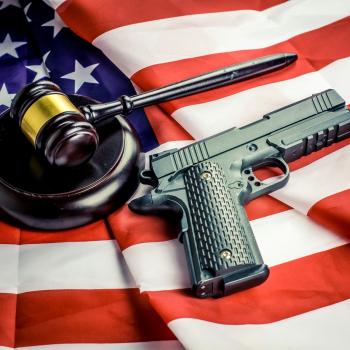In the comment box of Nate’s meditation on the U.S. response to 9/11, our own Alexham asked the following questions with regard to the motivating factors that led to President George W. Bush’s orders for the invasion, conquering and occupation of Iraq:
Could it be that the United States also took into consideration that Iraq was being ruled by a brutal dictator who had (and still was) committing genocide against his own people? And what are we to do in those circumstances? Turn a blind eye?
Christopher Blosser wrote sardonically of Alexham’s comment with seeming approval:
Come now, that’s crazy talk.
Since the invasion of Iraq, and especially since our government has come to the realization that no discernible link between Saddham Hussein’s regime and al-Qaeda and no trace of weapons of mass destruction other than the chemical weapons (of which we already aware) were found, the apologists of the Iraq War have made continual reference to the removal of a “brutal dictator” who continuously committed “genocide against his own people” both to support the the U.S. invasion and to bolster the image of the benevolence and global conscience of the Bush administration. And while the brutality of Saddham was frequently mentioned by Bush in the months and weeks leading up to the invasion and was listed as one of many justifications for that invasion, it was never cited as a definitive reason for war. Indeed, if we take a brief look at U.S. foreign policy since World War II, Bush’s alleged compassion for the Iraqi people can hardly be taken as anything more than mere tokenism.
The U.S. government over the past sixty years has quite a track record for political, economic and military support for the “brutal dictator” who commits “genocide against his own people.” This is an undeniable historical fact of American foreign policy, and to deny this fact is to delve into delusion. The government of the post-World World II United States has never been moved to remove a brutal dictator on account of his brutality, genocide and oppressive rule. Quite the contrary, in fact. The U.S. government has on a number of occasions supported and strengthened brutal dictators in whom it has discerned an political ally or with whom it has projected economic gain.
A few examples should illustrate this trend:
In 1933, U.S. Special Envoy to Cuba, Sumner Welles, who would later become Under Secretary of State under Franklin D. Roosevelt, supported the violent “Sergeants’ Revolt” that ousted Carlos Manuel de Céspedes. Fulgencio Batista was the leader of this revolt. The U.S. had been actively involved in deposing President Gerardo Machado since the late 1920’s in order to stabilize the Cuban political situation and open up economic lines between the two countries. The U.S. increased trade with Cuba when Fulgencio Batista was elected president in 1940. Batista held the presidential office until 1944, when he was defeated by Ramón Grau. However, in 1952 he ran for president again but trailed significantly in the polls. He staged a violent military coup in order to take over power, and U.S. President Harry Truman, despite the undemocratic and violent power snatching, formally recognized Batista as the President of Cuba. The U.S. supported Batista for economic reasons until 1958 when it was apparent that Batista’s lack of popularity among Cubans weakened economic viability. Only then was an arms embargo put into place. During its time of power, Batista’s regime was a violent and paranoid one. Many political prisoners were systematically executed for their opposition to Batista, and inmates of Cuban prisoners were tortured for information on any suspected insurrections. Batista’s was a gangster-run government; he used hired help to settle debts and to muscle business and he used the military to create an ambiance of fear and violence through street patrol, round-ups of those suspected of dissent and censorship of the press. Yet, despite Batista’s violence, murdering and suppression of human rights, the U.S. government supported his rule, even providing haven to him during and after his time in office. Not only did Batista represent an improvement in trade with Cuba for the U.S., he also ensured that the Soviets would have no hand in shaping the economic and political identity in Cuba (hence, the later vehement U.S. opposition to Castro).
I’ve mentioned before at this blog the “Dirty War” of Argentina, which lasted from 1976-1983. It was nearly a decade of violence carried out against Argentine citizens by presidents Jorge Rafael Videla, Roberto Eduardo Violaand, Leopoldo Galtieri and their successive military government. The government sought to obliterate all “leftist” resistance and influence within Argentine society. It is widely believed that up to 30,000 Argentine citizens and refugees from Chile and Uruguay disappeared during the Dirty War. They were arrested, tortured and killed, most of them being trade unionists and students. Seeing a neo-liberal and capitalist ally in the Argentine regimes, the U.S. was supportive of these military governments despite having knowledge of the systematic arrests and killings of civilians. Then-Secretary of State Henry Kissinger wished to remain friendly and supportive of Argentina in the late 1970’s on account of Videla’s anti-communist leanings. Kissenger apparently felt that having a Cold War ally was more important than objecting to the wide-spread human rights violations being committed in Argentina by far-right organizations (read: death squads) such as the Argentine Anticommunist Alliance. One cannot forget that Republican administrations of the second half of the twentieth century especially have had a penchant for supporting violent and oppressive regimes out of politico-economic interests (e.g., Pinochet, Batista and Abdullah). The Argentine government was given the impression that Washington was supportive of its actions despite the protest of the U.S. embassy in Argentina. Under Jimmy Carter, the U.S. backed off from its support of Argentina, but Ronald Reagan reversed this trend when he sought Argentine assistance in training Contras for guerrilla warfare in Nicaragua. The Ford and Reagan administrations turned a blind eye to the injustices and murders in Argentina, perceiving a greater good in bolstering neo-liberal (i.e., democratic capitalist) interests in Latin America and subverting a burgeoning Marxism in various Latin American countries. In 2002, the U.S. State Department declassified more than 4,600 documents pertaining to the Dirty War and U.S. involvement with, and support of, the Argentine regimes. The U.S. chose several times to ally itself out of economic interest with some of the most violent and cruel regimes of Latin America rather than standing up for the human rights of the innocent civilians.
Though there are many other dictators I can mention who were supported by the U.S. government, I believe I can close with a reminder that the U.S. not only helped put Saddam into power in the first place, but also supported him economically and militarily while he was committing genocide against his own people. After the overthrow of Shah Mohammad Reza Pahlavi, who had U.S. support, the Ayatollah Khomeini took control of Iran, inciting Shi’ite backlash against Saddam in Iraq. While fighting in the Iran-Iraq War, Saddam murdered, executed, imprisoned and tortured tens of thousands of Iraqis who were plotting against him or who were suspected of insurrection. The worst of Saddam’s genocide occurred during the period of this war, which happened to be when Saddam had the vigilant and stalwart support of the U.S. government. Ronald Reagan, who simultaneously aided Latin American dictators, gave $40 billion in aid to Saddam’s regime to combat Iran. According to The National Security Archive at George Washington University, Reagan gave Saddam additional billions as a bribe to keep Iraq from becoming a Soviet ally. Iraq was the third largest recipient of U.S. aid under the Reagan administration. Even after Saddam had used chemical weapons on Iran and on the Kurds of Iraq, Reagan and then-National Security Advisor Colin Powell opposed leveling any sanctions on Iraq. Iraq was a strategic ally both economically and politically, as its modernization was well underway and the country was seen as potentially a U.S. touchstone for influence in the Middle East and the bolstering of Israel (of course, none of this unrolled until 2003).
So whenever I read about how benevolent the current U.S. administration was in removing a “brutal dictator” for the sake of freedom of the innocent, I admire the dream but scoff at the naivete. It is not in our political blood to remove dictators simply to protect the innocent. When the U.S. has removed regimes or has attempted to do so (e.g., Iran, Cuba, Peru, Nicaragua) , it was always with the goal of forwarding the economic and political goals of U.S. foreign policy. On the flip side, in the past sixty years, the U.S. government has actually provided economic and political support for brutal dictators in exchange for economic productivity and allied resistance to communism or whatever ideology is considered to be maliciously opposed to the liberal democratic model. In between these two actions rests the most common option of U.S. foreign intervention: apathy. The U.S. is not in the business of removing dictators–no matter how brutal or how evil–if it will not help in accomplishing the goals of foreign policy. And Saddam is no exception. Relations with Saddam cooled in the early 1990’s, and ever since he threatened the oil market in 1991, the U.S. has had an invested interest in seeing to his demise. 2003 just so happened to offer that golden opportunity to Bush.












